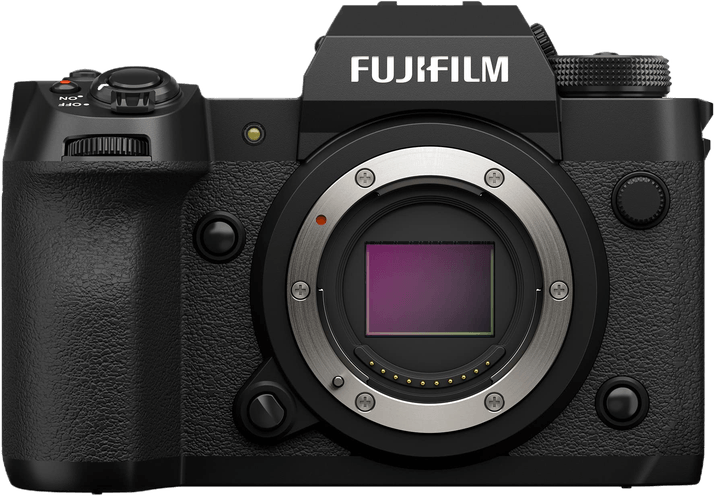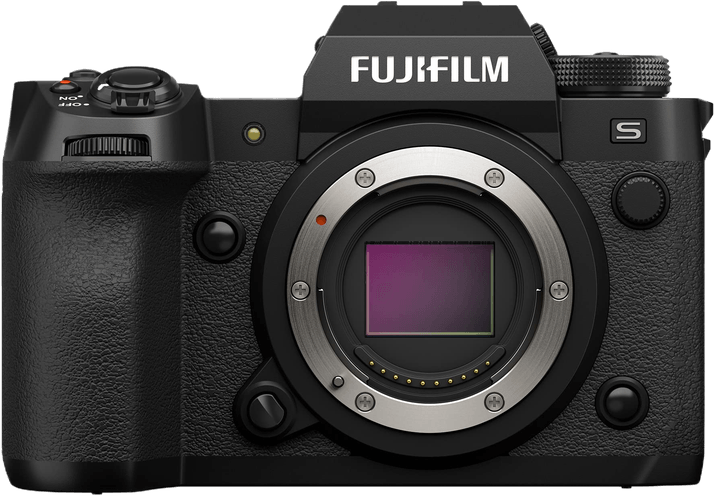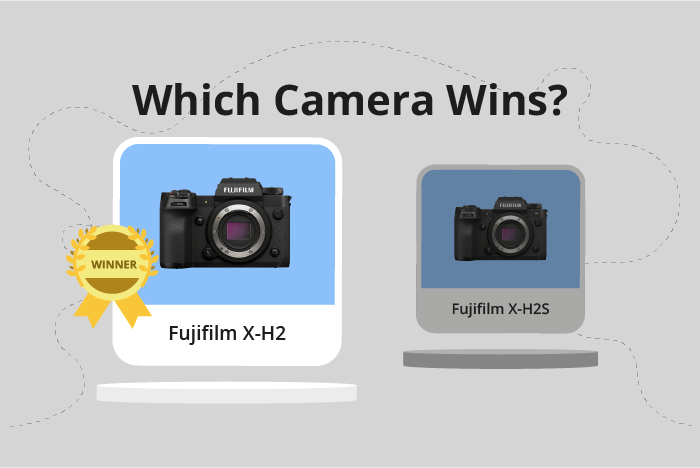Fujifilm X-H2 vs X-H2S Comparison
Fujifilm X-H2

Fujifilm X-H2S

The Fujifilm X-H2 takes the lead with a score of 82/100, while the Fujifilm X-H2S follows closely with a score of 79/100. Both cameras share several specifications, being mirrorless cameras announced on 05/31/2022 and released in the same year. They also have the same dimensions of 136 x 93 x 95mm and weigh 660g (1.46lbs).
The X-H2 is the more affordable option at $1999, making it a better choice for those on a budget. On the other hand, the X-H2S is priced at $2500, but it doesn’t offer any significant advantages over the X-H2 based on the information provided.
Taking into account the scores and prices, the Fujifilm X-H2 emerges as the winner in this comparison, providing a better value for money without sacrificing performance or features.
Fujifilm X-H2 vs X-H2S Overview and Optics
The Fujifilm X-H2 outperforms the Fujifilm X-H2S in optics with a score of 81/100 compared to 77/100. Both cameras share several common specifications, including the CMOS sensor type, X-Processor 5, APS-C sensor size, Fujifilm X lens mount, and image stabilization. However, there are key differences that contribute to the X-H2’s higher score.
The X-H2 boasts a superior 40-megapixel resolution, compared to the X-H2S’s 26 megapixels. This advantage results in greater image detail and improved cropping flexibility. Additionally, the X-H2 offers a shooting speed of 15 frames per second (fps), which is sufficient for most photography needs.
On the other hand, the X-H2S excels in shooting speed, reaching an impressive 40 fps, making it ideal for capturing fast action and sports photography. Despite its lower overall optics score, the X-H2S’s speed advantage could be a deciding factor for photographers who prioritize capturing fast-moving subjects.
Considering the optics performance of both cameras, the Fujifilm X-H2 emerges as the better choice for photographers seeking higher resolution and image detail. Its 40-megapixel sensor and 15 fps shooting speed cater to a wide range of photography needs. However, the Fujifilm X-H2S remains a strong contender for those who prioritize high-speed shooting capabilities, offering a remarkable 40 fps. Ultimately, the choice between these two cameras depends on the specific requirements and preferences of the photographer.
Fujifilm X-H2 vs X-H2S Video Performance
The Fujifilm X-H2 and Fujifilm X-H2S both have a video score of 83/100, indicating that they have similar video capabilities. Both cameras offer 4K video resolution and a maximum video frame rate of 60fps. Additionally, they both have time-lapse functionality built in, making them suitable for capturing dynamic scenes over a period of time.
While the video capabilities of the two cameras are largely the same, there are some differences in their specifications. The X-H2S has a slightly higher maximum video dimension of 4096 x 2160, compared to the X-H2’s 3840 x 2160. This means that the X-H2S can produce higher resolution videos, which may be important for those looking for the best possible image quality.
On the other hand, the X-H2 does not have any specific advantages over the X-H2S in terms of video capabilities. Both cameras are evenly matched in their video performance, with the only difference being the slightly higher video dimensions offered by the X-H2S.
Taking into account the similarities and differences in video capabilities, it is clear that both the Fujifilm X-H2 and X-H2S are capable cameras for video recording. While the X-H2S has a slight edge in terms of maximum video dimensions, the difference is not significant enough to declare a clear winner between the two models. Therefore, both cameras are suitable options for those looking to capture high-quality video footage, with the choice ultimately coming down to personal preferences and other factors, such as price and additional features.
Fujifilm X-H2 vs X-H2S Features and Benefits
The Fujifilm X-H2 and Fujifilm X-H2S tie with a feature score of 85/100. Both cameras share the same specifications in several areas, making it difficult to declare a clear winner.
Both cameras have a 3-inch screen size, 1,620,000-dot screen resolution, touchscreen functionality, flip screen, WIFI, and Bluetooth. Neither camera has GPS. These common features make both cameras suitable for various photography and videography needs.
Despite the tied scores, there are areas where one camera could be better than the other. However, based on the provided specifications, no such differences are evident. The Fujifilm X-H2 and X-H2S are evenly matched, and neither camera has an advantage over the other.
In cases like this, it is crucial to consider individual preferences and needs when choosing between the two cameras. Factors such as price, availability, and additional accessories may come into play when making a decision.
Given the equal feature scores and identical specifications, both the Fujifilm X-H2 and X-H2S are excellent choices for photographers and videographers. Ultimately, the decision lies in personal preferences and specific requirements that may not be reflected in the provided specifications.
Fujifilm X-H2 vs X-H2S Storage and Battery
The Fujifilm X-H2 outperforms the X-H2S in storage and battery with a score of 79/100, compared to the X-H2S’s 76/100. Both cameras share similarities, including two memory card slots, accepting CFexpress Type B and SD (UHS-II Compatible) cards, and featuring NP-W235 batteries with USB charging capabilities.
The X-H2 excels with a longer battery life, providing 680 shots, which is 100 more than the X-H2S’s 580 shots. This advantage allows for extended shooting sessions without the need for frequent battery replacements or recharging.
Although the X-H2S has a slightly lower score, it still offers decent storage and battery capabilities. However, the difference in battery life is the primary factor separating the two models.
Considering the storage and battery aspects, the Fujifilm X-H2 proves to be a better choice for photographers seeking longer battery life and reliable storage options. Nonetheless, the X-H2S remains a viable option for those who do not prioritize extended battery life.
Alternatives to the Fujifilm X-H2 and X-H2S
Are you still undecided about which camera is right for you? Have a look at these popular comparisons that feature the Fujifilm X-H2 or the Fujifilm X-H2S:

